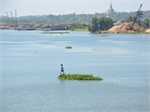The dead sections of the river

A report showed that there are 39 underground water wells managed by the Saigon Water Supply Company. Of these, 11 wells were built after 1975, while the other old wells have been repaired and exploited to provide water to the city.
There are also other underground wells funded by UNICEF, namely the Hoc Mon Water Plant with the capacity of 50,000 cubic meters a day that provides clean water to districts 6, 11 and Binh Tan, and the Binh Tri Dong water supply station, 12,000 cubic meters a day. HCM City’s dwellers have also been using water from some 100,000 wells built by themselves.
However, the underground water quality has been degrading seriously due to the serious pollution of the rivers and canals. Therefore, HCM City has been relying on some key water supply plants.
These include the Thu Duc water plant which has the capacity of 750,000 cubic meters per day, the Binh An BOT water plant 100,000 cubic meters and the Tan Hiep 300,000 cubic meters. All the three plants use the water from the Dong Nai River.
However, the Dong Nai River, the main water supply source for the water plants, has also become seriously polluted. The Ministry of Natural Resources and the Environment reported that the river’s water quality is getting worse with many sections of the river getting “dead” because of the overly high pollution.
The water of the Saigon River, which begins from the Thi Tinh river mouth, has been found as having pollution in organics and microorganisms. In the river section that runs across HCM City, the BOD5, COD and microorganism indexes all cannot meet the standards to serve as the clean water for domestic use.
The indexes about the water quality provided by monitoring stations showed the degradation in the quality. The downstream of the Dong Nai River has also been facing the salinity intrusion.
In November 2012, the salinity level measured on the Thi Vai River hovered around 10.2 and 24.9 ‰, or 2‰ higher than that in September 2012.
The salinity level has been increasing rapidly since 2009. In that year, the salinity was measured at 1,700mg per liter, while it rose to 3,400 mg per liter in the dry season of 2011. As a result, water supply plants have to pay more money on necessary chemicals to process the raw water, thus leading to the higher water production costs.
Meanwhile, healthcare experts pointed out that the increase in the volumes of chemicals used can only settle some major problems, while the current ways of treatment still does not allow eliminating some kinds of heavy metals.
Environmentalists have warned that with the current speedy sea water rise and the operation of a series of hydropower plants on the Dong Nai River, the salinity intrusion would be even more serious, which may reach out to the Hoa An raw water pumping station.
Water reservoirs raise worries
A series of irrigation and hydropower plants have been and would be built on the upstream of the Dong Nai River, which has been considered the big threat to the city.
It is expected that 14 hydropower plants would be set up on the main stream of the Dong Nai River. All of them are big and medium scaled, of which six have been operational.
Experts have warned that the water reservoirs of the hydropower plants would be the “bombs” to be dropped into the city.
(NLD)